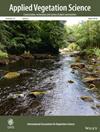Modeling the Abundance of Boreal Foundation Species: The Impact of Forest Structure, Soils, and Legacy Effects on Ericaceous Shrubs
Abstract
Aims
The dwarf shrubs Calluna vulgaris, Vaccinium myrtillus, and V. vitis-idaea are functionally important species in boreal forest, driving ecosystem processes and delivering multiple ecosystem services. Their dependency on previous and present land-use calls for tools to estimate the outcomes of different forest management strategies on their abundance. Here we built models for estimating their cover as a response to forest structure, soils, and legacy effects, with the ultimate target to be used in decision support systems to be able to adapt future management.
Location
Sweden.
Methods
We fitted Generalized Linear Mixed Models with beta error distribution, and accounting for zero-inflation, based on data (n > 2800) on plant cover, forest structure, and soils from the Swedish National Forest Inventory.
Results
The resulting best models include forest density and tree species composition, and their interaction effects, likely governing the light availability in the forest understory for all three species. These models also included soil fertility indicated by the C:N ratio, the age of the forest as an indicator of time since disturbance, and the cover of the focal species 10 years earlier to account for legacy and time-lag effects. Although these variables were important for the model predictions of all three species, there were interspecific differences in the response due to the stress tolerance of the species and their placement in the leaf economics spectrum.
Conclusions
We show that it is possible to predict the cover of these species with higher accuracy (R2 = 0.44–0.60) than previously has been achieved, using predictors available from for example, national forest inventories. Hence, our models will improve the estimations of the outcomes of different forest management strategies on the cover of these species. This will be important when weighing pros and cons for ecosystem functions and services, and thus imperative for sustainable forest management.


 求助内容:
求助内容: 应助结果提醒方式:
应助结果提醒方式:


